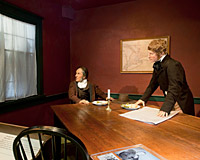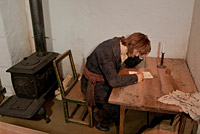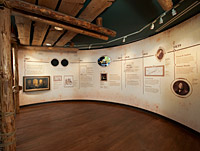Canada Hall
 From Rebellions to Confederation, 1837–1867
From Rebellions to Confederation, 1837–1867
From Rebellions to Confederation, 1837–1867 takes us through the tumultuous 30-year period that preceded Confederation, beginning with the Upper and Lower Canada Rebellions of 1837–1838.
Reformers rose up against British colonial rule to fight for democracy—the right of the people to elect those who would govern them—and an end to the privileges of the aristocracy. While the rebels lost their battles, their efforts planted the seeds of responsible government and laid the foundations for a new country: Canada.
DECEMBER 4, 1837 — TROUBLE BREWING IN UPPER CANADA
From Rebellions to Confederation begins where the United Empire Loyalists section ends.
Visitors walk through Montgomery Tavern in Toronto and find themselves amidst the rebels led by journalist William Lyon Mackenzie. Furious because their proposed democratic reforms were rejected, the rebels left the tavern on December 4, 1837, armed with muskets, pitchforks and staves.
They confronted the larger, better-equipped colonial militia in a series of battles that culminated on December 7, when colonial forces attacked the tavern and burned it to the ground. The rebels scattered and many were arrested. Mackenzie and some of his followers escaped to the United States where they continued to lead raids. The Rebellion ended with Mackenzie's defeat at the Battle of the Windmill at Prescott in November 1838.
NOVEMBER 1837 — REBELLION CRUSHED IN LOWER CANADA
From the tavern, visitors walk to Montréal's Pied-du-courant Prison, where 1,367 Patriotes were locked up between 1837 and 1839 for their role in the Lower Canada Rebellion. Political leader Louis-Joseph Papineau spearheaded the revolt, which simmered for years before erupting on November 23, 1837. On that day, rebel forces won a battle at Saint-Denis. The fighting continued at Saint-Charles and Saint-Eustache, where British troops looted and torched houses and barns. It finally ended in November 1838, when British and colonial forces overcame the Patriotes at Beauharnois, Odelltown and Lacolle. In all, 300 Patriotes and 27 government soldiers were killed, 12 rebels were hanged, and 58 were sent to penal colonies in Australia.
This room evokes the harsh conditions endured by the prisoners. The walls are covered with dirt and graffiti, and a cramped cell represents the space shared by up to four men. A prisoner sits at a table in the common room, writing a letter to his wife. Visitors can listen to popular nineteenth-century ballads recounting the plight of the Patriotes.
Around the room, visitors discover various historical artifacts, such as Papineau's snuffbox and pocket watch, and the ceinture fléchée sash of Dr. Jean-Olivier Chénier, who led the Patriotes at Saint-Eustache. Broken pieces of a door handle tell a gruesome tale. The handle is believed to be from the church at Saint-Eustache where some 70 Patriotes died when British troops set the building ablaze in December 1837.
A BRITISH OFFICER'S QUARTERS
Next to the prison's common room, visitors find a fascinating re-creation of a Cornelius Krieghoff painting that illustrates the leisure pursuits of a British officer in Montréal in the 1840s, shortly after the Rebellions were quelled. The colourful room is filled with zoological, botanical and ethnographic specimens. There are also many sketches and watercolours, as well as sports equipment, and fishing and riding gear.
1839–1867 — THE PATH TO CONFEDERATION
The grim confines of the prison lead to a brighter space, where a multimedia timeline introduces visitors to key events and characters in the years following the Rebellions. These include Lord Durham, the Governor General who recommended the establishment of responsible government and a merger of Upper and Lower Canada. He angered French Canadians by calling for their assimilation. This led to the 1841 Act of Union, which united the two regions, made English the only official language, and gave Canada East (Lower Canada) proportionally fewer elected representatives.
Robert Baldwin and Louis-Hippolyte Lafontaine formed a coalition to lead the Union, and vowed to introduce a responsible parliamentary government. In 1849, they passed legislation to compensate people mainly French Canadians—who had lost property during the Lower Canada Rebellion. The new Governor General, Lord Elgin, refused to veto the law, thus sparking riots in Montréal. A video shows how an English mob set Parliament—which was then in Montréal—on fire. There's also an unusual souvenir of the riots: two rocks that Lady Elgin saved and inscribed after they were thrown at her husband.
The timeline then takes visitors to the Charlottetown and Québec Conferences in 1864, where John A. Macdonald and George-Étienne Cartier met with delegates from Nova Scotia, New Brunswick and Prince Edward Island to discuss a political union.
The negotiations led directly to Confederation on July 1, 1867, an attempt to carefully balance regional and national governments and introduce democratic reforms, economic links, and legal foundations for language rights. Thirty years after the Rebellions set the process in motion, most—but not all—Reformers embraced the new country.





